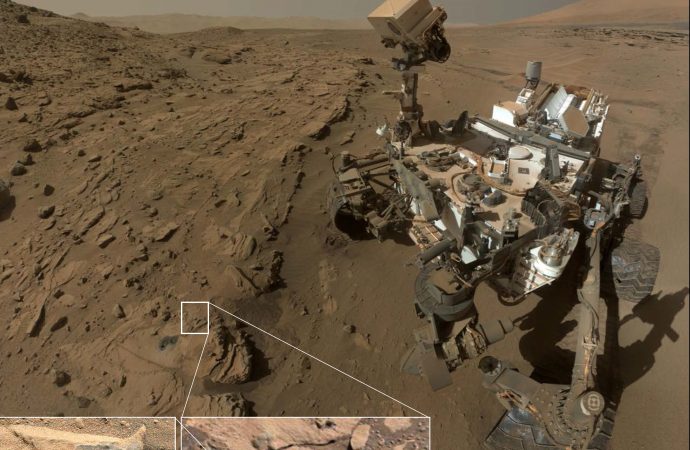Chemicals found in Martian rocks by NASA’s Curiosity Mars rover suggest the Red Planet once had more oxygen in its atmosphere than it does now.
Chemicals found in Martian rocks by NASA’s Curiosity Mars rover suggest the Red Planet once had more oxygen in its atmosphere than it does now.
Researchers found high levels of manganese oxides by using a laser-firing instrument on the rover. This hint of more oxygen in Mars’ early atmosphere adds to other Curiosity findings — such as evidence about ancient lakes — revealing how Earth-like our neighboring planet once was.
This research also adds important context to other clues about atmospheric oxygen in Mars’ past. The manganese oxides were found in mineral veins within a geological setting the Curiosity mission has placed in a timeline of ancient environmental conditions. From that context, the higher oxygen level can be linked to a time when groundwater was present in the rover’s Gale Crater study area.
“The only ways on Earth that we know how to make these manganese materials involve atmospheric oxygen or microbes,” said Nina Lanza, a planetary scientist at Los Alamos National Laboratory in New Mexico. “Now we’re seeing manganese oxides on Mars, and we’re wondering how the heck these could have formed?”
Microbes seem far-fetched at this point, but the other alternative — that the Martian atmosphere contained more oxygen in the past than it does now — seems possible, Lanza said. “These high manganese materials can’t form without lots of liquid water and strongly oxidizing conditions. Here on Earth, we had lots of water but no widespread deposits of manganese oxides until after the oxygen levels in our atmosphere rose.”
Lanza is the lead author of a new report about the Martian manganese oxides in the American Geophysical Union’s Geophysical Research Letters. She uses Curiosity’s Chemistry and Camera (ChemCam) instrument, which fires laser pulses from atop the rover’s mast and observes the spectrum of resulting flashes of plasma to assess targets’ chemical makeup.
In Earth’s geological record, the appearance of high concentrations of manganese oxide minerals is an important marker of a major shift in our atmosphere’s composition, from relatively low oxygen abundances to the oxygen-rich atmosphere we see today. The presence of the same types of materials on Mars suggests that oxygen levels rose there, too, before declining to their present values. If that’s the case, how was that oxygen-rich environment formed?
“One potential way that oxygen could have gotten into the Martian atmosphere is from the breakdown of water when Mars was losing its magnetic field,” said Lanza. “It’s thought that at this time in Mars’ history, water was much more abundant.” Yet without a protective magnetic field to shield the surface, ionizing radiation started splitting water molecules into hydrogen and oxygen. Because of Mars’ relatively low gravity, the planet wasn’t able to hold onto the very light hydrogen atoms, but the heavier oxygen atoms remained behind. Much of this oxygen went into rocks, leading to the rusty red dust that covers the surface today. While Mars’ famous red iron oxides require only a mildly oxidizing environment to form, manganese oxides require a strongly oxidizing environment, more so than previously known for Mars.
Lanza added, “It’s hard to confirm whether this scenario for Martian atmospheric oxygen actually occurred. But it’s important to note that this idea represents a departure in our understanding for how planetary atmospheres might become oxygenated.” Abundant atmospheric oxygen has been treated as a so-called biosignature, or a sign of extant life, but this process does not require life.
Curiosity has been investigating sites in Gale Crater since 2012. The high-manganese materials it found are in mineral-filled cracks in sandstones in the “Kimberley” region of the crater. But that’s not the only place on Mars where high manganese abundances have been found. NASA’s Opportunity rover, exploring Mars since 2004, also recently discovered high manganese deposits thousands of miles from Curiosity. This supports the idea that the conditions needed to form these materials were present well beyond Gale Crater.
Los Alamos National Laboratory leads the U.S. and French team that jointly developed and operates ChemCam. NASA’s Jet Propulsion Laboratory, a division of Caltech in Pasadena, California, built the rover and manages the Curiosity mission for NASA’s Science Mission Directorate, Washington.
Guy Webster
Jet Propulsion Laboratory, Pasadena, Calif.
818-354-6278
guy.webster@jpl.nasa.gov
Laura Mullane
Los Alamos National Laboratory, Los Alamos, N.M.
505-667-6012
mullane@lanl.gov
2016-161


































Leave a Comment
You must be logged in to post a comment.